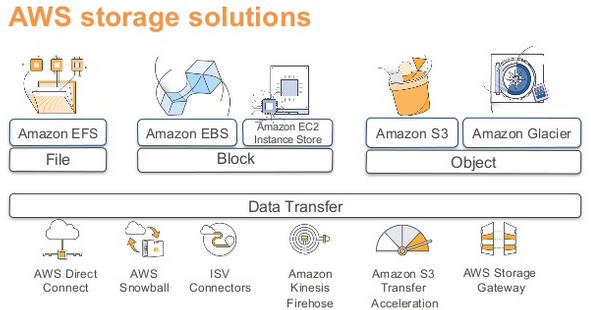Determine Appropriate Data Structure and Storage Format

Object storage
Amazon Simple Storage Service (Amazon S3) is highly durable, general-purpose object storage that works well for unstructured data sets such as media content. Amazon S3 provides the highest level of data durability and availability on the AWS Cloud. There are three tiers of storage: one each for hot, warm, or cold data. In terms of pricing, the colder the data, the cheaper it is to store, and the costlier it is to access when needed. You can easily move data between these storage options to optimize storage costs:
- Amazon S3 Standard – The best storage option for data that you frequently access. Amazon S3 delivers low latency and high throughput and is ideal for use cases such as cloud applications, dynamic websites, content distribution, gaming, and data analytics.
- Amazon S3 Standard – Infrequent Access (Amazon S3 Standard – IA) – Use this storage option for data that you access less frequently, such as long-term backups and disaster recovery. It offers cheaper storage over time, but higher charges to retrieve or transfer data.
- Amazon Glacier – Designed for long-term storage of infrequently accessed data, such as end-of-lifecycle, compliance, or regulatory backups. Different methods of data retrieval are available at various speeds and cost. Retrieval can take from a few minutes to several hours.
Block Storage
Amazon Elastic Block Store (Amazon EBS) volumes provide a durable block-storage option for use with EC2 instances. Use Amazon EBS for data that requires long-term persistence and quick access at guaranteed levels of performance. There are two types of block storage: solid-state-drive (SSD) storage and hard-disk-drive (HDD) storage.
SSD storage is optimized for transactional workloads where performance is closely tied to IOPS. There are two SSD volume options to choose from:
- EBS Provisioned IOPS SSD (io1) – Best for latency-sensitive workloads that require specific minimum-guaranteed IOPS. With io1 volumes, you pay separately for provisioned IOPS, so unless you need high levels of provisioned IOPS, gp2 volumes are a better match at lower cost.
- EBS General Purpose SSD (gp2) – Designed for general use and offer a balance between cost and performance.
HDD storage is designed for throughput-intensive workloads such as data warehouses and log processing. There are two types of HDD volumes:
- Throughput Optimized HDD (st1) – Best for frequently accessed, throughput-intensive workloads.
- Cold HDD (sc1) – Designed for less frequently accessed, throughput-intensive workloads.
File Storage
Amazon Elastic File System (Amazon EFS) provides simple, scalable file storage for use with EC2 instances. Amazon EFS supports any number of instances at the same time. Its storage capacity can scale from gigabytes to petabytes of data without needing to provision storage. Amazon EFS is designed for workloads and applications such as big data, media-processing workflows, content management, and web serving. Amazon EFS also supports file synchronization capabilities so that you can efficiently and securely synchronize files from on-premises or cloud file systems to Amazon EFS at speeds of up to 5 times faster than standard Linux copy tools.
Amazon S3 and Amazon EFS allocate storage based on your usage and you pay for what you use. However, for EBS volumes, you are charged for provisioned (allocated) storage whether or not you use it. The key to keeping storage costs low without sacrificing required functionality is to maximize the use of Amazon S3 when possible and use more expensive EBS volumes with provisioned I/O only when application requirements demand it.
